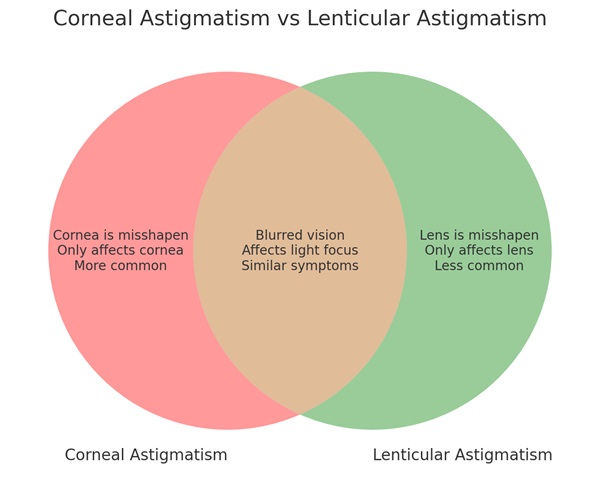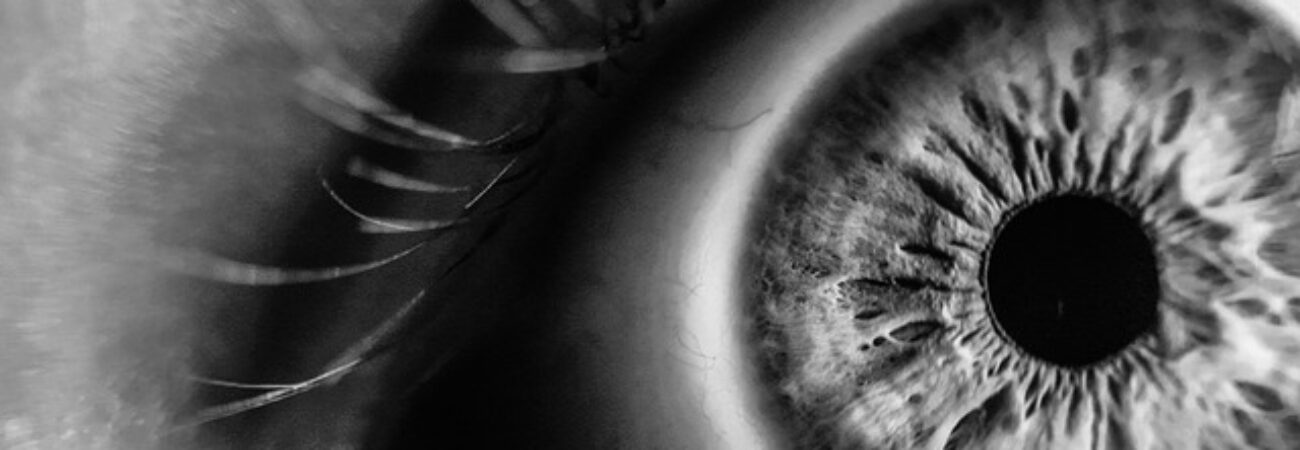Having difficulty reading the road signs and seeing the lights clearly at night? Do you suffer from eye strain and headaches? These could be signs of astigmatism.
According to Epidemiology and Burden of Astigmatism: A Systematic Literature Review, untreated astigmatism symptoms can impact your daily activities and quality of life. Understanding its causes and treatments early can help you mitigate its effects and improve your overall vision health.
What is Astigmatism?
Astigmatism is a common eye condition that causes blurry or distorted vision. It occurs when your cornea (the clear front surface of your eyes) or lens is irregularly shaped. It also affects your eye’s ability to focus light onto your retina.
To understand how this happens, it’s important to learn about the role of meridians in the eyes.
Role of Meridians in the Eyes
Meridians are imaginary lines that run across the centre of the eye, similar to the lines on a clock connecting 12, 3, 6, and 9. These lines help us understand how light bends as it enters your eyes.
Healthy Eyes vs. Astigmatism
In healthy eyes, the cornea is smoothly curved along all meridians. This means light is bent equally in all directions and focuses perfectly on your retina at the back of your eyes, giving you clear, undistorted vision.
However, in astigmatism, your cornea or lens isn’t evenly curved. It has different curvatures along its meridians, leading you to have blurry and distorted vision.
Understanding meridians in eyes, whether normal or affected by astigmatism, is crucial for optometrists to determine your type of astigmatism. Let’s explore its different classifications.
Astigmatism Classifications
Astigmatism can affect different parts of your eye: the cornea, lens, or retina. Depending on the meridian, it can be classified as with-the-rule, against-the-rule, oblique, or bi-oblique astigmatism.
- With-the-Rule Astigmatism
The vertical meridian is steeper than the horizontal, needing a concave cylinder at 180° or a convex cylinder at 90°. - Against-the-Rule Astigmatism
The horizontal meridian is more curved, requiring a convex cylinder at 180° or a concave cylinder at 90°. - Oblique Astigmatism
Principal meridians are angled, like at 45° and 135°. - Bi-oblique Astigmatism
Principal meridians are not at right angles, like at 20° and 110°. - Mixed Astigmatism
Light focuses in front of the retina in one meridian and behind in the other.
Types of Astigmatism
Astigmatism can be classified into the following types.
1. Corneal Astigmatism
Corneal astigmatism occurs when the cornea is irregularly shaped, leading to blurred vision. There are two types of corneal astigmatism:
- Regular Astigmatism
This happens when your cornea is curved more in one direction than the other, like a football.
- Irregular Astigmatism
In this case, your cornea’s curvature is uneven, curving in multiple directions. It can result from eye injuries, infections, or conditions like keratoconus, which cause the cornea to thin over time.
2. Lenticular Astigmatism
Lenticular astigmatism happens when the lens is misshapen, causing blurred vision.
Check the Venn diagram below to see their differences:

How Astigmatism Exists with Myopia and Hyperopia
Astigmatism can also occur alongside other vision problems like shortsightedness or longsightedness. It can be classified as simple or compound astigmatism.
Simple Vs. Compound Astigmatism
Here’s a table for a better understanding of simple and compound astigmatism
| Astigmatism (Simple or Compound) | Description |
| Simple Myopic Astigmatism | Light focuses in front of your retina in one meridian (shortsightedness) |
| Simple Hypermetropic Astigmatism | Light focuses behind your retina in one meridian (longsightedness) |
| Compound Myopic Astigmatism | Light focuses in front of your retina in both meridians |
| Compound Hypermetropic Astigmatism | Light focuses behind your retina in both meridians |
1. Myopic Astigmatism: Focusing Before the Retina
In myopic astigmatism, your eye’s principal meridians focus light in front of your retina.
2. Hyperopic Astigmatism: Focusing Beyond the Retina
Hyperopic astigmatism occurs when one or both meridians focus light behind your retina with both focal points at different locations.
3. Mixed Astigmatism: Combining Farsightedness and Nearsightedness
Mixed astigmatism involves one meridian focusing light in front of the retina and the other behind it. This results in both focal points lying at different positions.
How to Know If You Have Astigmatism
Now that you are informed about the classifications of astigmatism, here are the signs and symptoms you must be aware of.

Astigmatism vs Normal Vision
If you have astigmatism, light entering your eyes doesn’t bend properly, preventing it from focusing accurately on your retina. This part of your eye then sends images to your brain. As a result, objects like traffic lights appear blurry or wavy.
See the detailed comparison table below:
| Comparison | Normal Vision | Astigmatism |
| Light Appearance | Lights form a softer halo shape. | Lights appear fuzzy, streaky, or surrounded by haloes, especially at night. |
| Cornea Shape | The cornea and lens are spherical, allowing smooth light passage to the retina. | Distorted cornea scatters light, causing this effect. |
| Night Vision | Clear and sharp vision at all times. | Blurry vision is more noticeable at night due to pupil dilation. |
| Glare and Streaks | Colours are seen more clearly, with less glare and no light sensitivity. | Increased glare and streaks at night make driving difficult. |
Astigmatism Symptoms
Blurred vision is the most common symptom of astigmatism. You may find it hard to see details like menu text or road signs. Other symptoms include:
- Fatigue
- Eye strain (when focused on something for too long, such as concentrating on your computer screen or reading a book)
- Headaches
- Seeing glares or halos around lights
- Squinting to see clearly
Young children might not realise their vision is poor. If you notice them squinting, rubbing their eyes, or having frequent headaches, visit an eye care specialist.
Causes of Astigmatism
Astigmatism is often hereditary, meaning it is passed down from your parents. It can also be caused by excessive pressure on the cornea from your eyelids. Although health conditions don’t usually cause it here are some causes you need to be aware of:
- Age: As the eye ages, its likelihood of developing astigmatism increases.
- Eye Disease: Conditions like glaucoma, conjunctivitis, and phoria (eye misalignment) can increase the risk of astigmatism.
- Eye Injury: Trauma to the eye can alter its structure, leading to astigmatism.
- Eye Surgery: Procedures on the eye can result in residual astigmatism.
- Keratoconus: This eye condition causes the cornea to become dome-shaped, causing blurred vision and light sensitivity.
Astigmatism Diagnosis
There are several tests optometrists and ophthalmologists may use during your eye examination to diagnose astigmatism.
1. Visual Acuity Test
In a visual acuity test, your doctor will ask you to read letters from a chart at a certain distance, which helps determine how well you can see the letters.
2. Refraction Test
A refraction test uses a device called an optical refractor. This machine has various corrective lenses. Your doctor will ask you to read a chart while looking through these lenses. They will keep changing the lenses until they find the right one for you.
3. Corneal Topography
This test provides detailed information about the shape and curve of your cornea.
4. Keratometry
Keratometry measures the curvature of your cornea. Your doctor will use a device called a keratometer to examine your eyes.
5. Slit Lamp Exam
A slit lamp is a special microscope with a bright light that shines into your eye. Your eye specialist will adjust the brightness and width of the light beam to examine the different layers and parts of your eye.
Astigmatism Treatment
Astigmatism can be treated. Here are several ways to regain your clear vision:
1. Eyeglasses
Eyeglasses are often the first choice. They have cylindrical lenses to correct blurriness. Most people get single-vision lenses, but bifocals or progressive lenses are prescribed for those over 40. You can choose from different frame brands to suit your styles and facial features.
2. Corrective Contact Lenses
Contact lenses (daily vs. monthly contacts) can improve vision better than glasses because they can give a wider field of view. However, they require regular cleaning. For astigmatism, special “toric” lenses are used. Additionally, rigid gas-permeable lenses can effectively maintain their shape to correct your cornea.
3. Orthokeratology
Also known as “ortho-k,” this treatment uses rigid contact lenses worn overnight to reshape the cornea temporarily. It’s not a permanent fix and your vision can return to its previous state if you stop wearing the lenses regularly.
4. Refractive Surgery
LASIK and PRK are surgical procedures that reshape your cornea to correct astigmatism. LASIK removes tissue from your inner cornea, while PRK removes tissue from both the outer and inner layers.
Here is a quick guide to astigmatism surgery options:
| Surgery | Procedure |
| Laser in situ keratomileusis (LASIK) | Cuts a thin flap in the cornea and then uses a laser to reshape it before closing the flap. |
| Photorefractive keratectomy (PRK) | Uses a laser to reshape the cornea, improving how light focuses on the retina |
| Laser-assisted subepithelial keratectomy (LASEK) | Loosens the protective cover over the cornea and uses a laser to correct its shape |
| Small incision lenticule extraction (SMILE) | Reshapes the cornea by using a laser to create a disc-shaped piece of tissue below its surface |
| Epi-LASIK | Removes the top layer of the cornea and then uses a laser to reshape it. |
Astigmatism is Manageable
If astigmatism is left untreated, it can cause coordination problems that can inconveniently affect your daily life. But don’t worry! It is a treatable condition. Your awareness is the first step to managing it. You don’t need to panic when astigmatism symptoms occur.
How EyeSelect Can Help You with Astigmatism Symptoms
The sooner your astigmatism is identified, the better your chances of a complete recovery. Never miss your scheduled eye exams if you want healthy and well-functioning eyes.
At EyeSelect, our highly skilled optometrists provide comprehensive optometry services that can help you. We also educate you on how to care for your eyes through our blogs.
Need an eye check-up? Book an appointment with us today!





